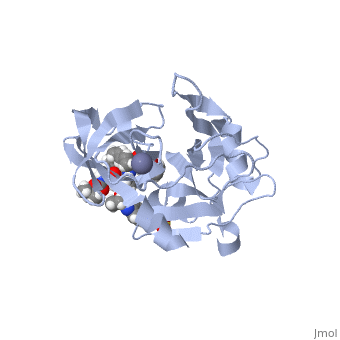This is a default text for your page Megan Harris./Sandbox 1. Click above on edit this page to modify. Be careful with the < and > signs.
You may include any references to papers as in: the use of JSmol in Proteopedia [1] or to the article describing Jmol [2] to the rescue.
Function
Structure and Mechanism of Elbasvir
Elbasvir, MK-8742,a tetra-cyclic indole based NS5A inhibitor, was experimentally obtained through the modification of MK-4882. Through efficacy studies of infected chimpanzees, Elbasvir was discovered as a diastereomer of the known compound, MK-4882 [3]. Elbasvir has a structural formula of C49H55N9O7 and a molecular weight of 882.035 g/mol. It is a highly flexible protein with 13 rotatable bonds. It has four hydrogen bond donors and nine hydrogen bond acceptors [4].
Although the actual mechanism of Elbasvir as a NS5A inhibitor is unknown, several hypothetical mechanisms have been proposed. The NS5A protein is a critical protein for both DNA replication and assembly in the hepatitis C virus. With critical roles in both processes, NS5A is an excellent source as a target for inhibitors. NS5A is naturally located in the endoplasmic reticulum of the cell. When inhibited, the protein is redistributed from the ER to lipid droplets. If the cellular location changed, NS5A would be unable to aid in viral replication, illustrating a form of protein inhibition that Elbasvir could cause. Another potential mechanism of NS5A inhibitors is the altering of the phosphorylation of the NS5A protein [5]. The function of the NS5A protein is highly dependent on the phosphorylation, both basal phosphorylation and hyperphosphorylation [6]. Since the phosphorylation of the NS5A protein is critical for protein function, altering the levels could impact the activity of the protein.
Mechanism of Grazoprevir
Disease
Hepatitis C, hereafter known as HCV, is a viral infection that causes inflammation of the liver and decreasing liver functioning. First isolated by Michael Houghton in 1989, hepatitis C was discovered to encode a single polyprotein of 3,000 amino acids later cleaved into 10 polypeptides. Polypeptides produced include p7 ion channel proteins, the core protein, glycoproteins envelope 1 (E1) and envelope 2 (E2), and nonstructural proteins NS1, NS2, NS3, NS4A, NS5A, and NS5B. The 5’ untranslated region of HCV is not capped, allowing it to fold into a complex secondary RNA structure hereby creating an internal ribosome entry site that is able to direct ribosomal subunits, cellular factors, and as a result, translation. Development of cell culture based model systems have allowed for the study of the HCV lifecycle [7].
HCV is transmitted exclusively through blood whereupon the virus travels to the hepatocytes of the liver to undergo rapid replication. This results in the inflammation of the liver, leading to decreased function and/or liver failure. HCV induces an immune response within the infected individual which commonly fails to restrict the development of chronicity.
While six distinct genotype of HCV were discovered, genotypes 1 is the most prevalent amongst populations and the most difficult to treat. Increased resistance of the virus at the M28, Q30, L31, or Y93 results in decreased effectiveness of pharmaceuticals against genotype 1. Genotype 1 results from the infection of human lymphoid cells by the virus. Genotype 4 has recently increased in prevalence, resulting in attempts to decrease transmission.
Zepatier is a combination drug designed for the treatment of individuals with end stage renal disease on dialysis, typically genotype 1 infected patients. The drug is also utilized to treat genotype 4 patients when other methods of treatment prove ineffective [8].
Relevance
Structural highlights
This is a sample scene created with SAT to by Group, and another to make of the protein. You can make your own scenes on SAT starting from scratch or loading and editing one of these sample scenes.

